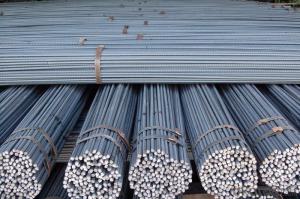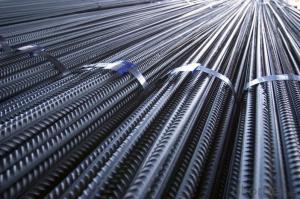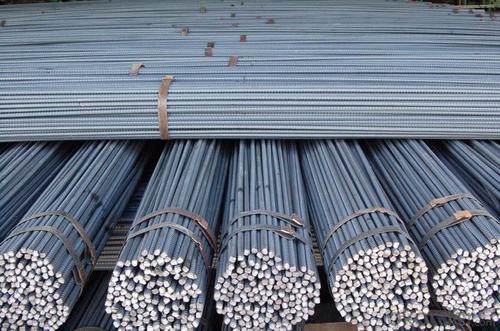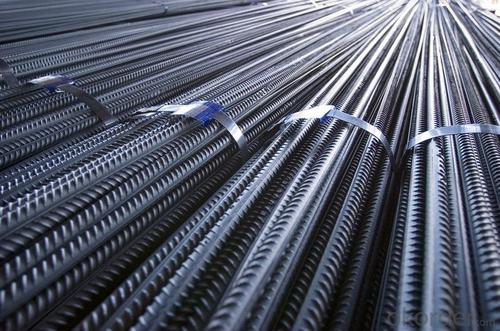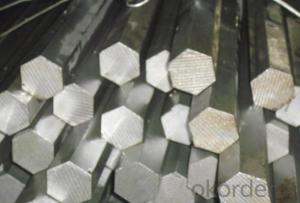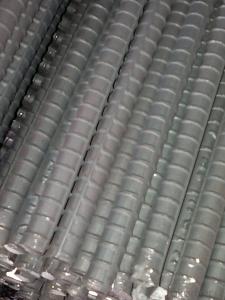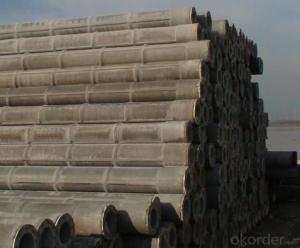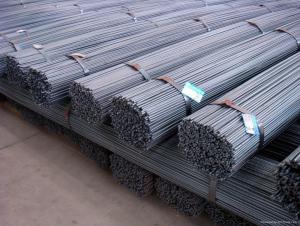Hot Rolled Deformed bars with High Quality
- Loading Port:
- Tianjin
- Payment Terms:
- TT OR LC
- Min Order Qty:
- 25 m.t.
- Supply Capability:
- 10000 m.t./month
OKorder Service Pledge
OKorder Financial Service
You Might Also Like
OKorder is offering Deformed Steel Bar with high quality at great prices with worldwide shipping. Our supplier is a world-class manufacturer of steel, with our products utilized the world over. OKorder annually supplies products to European, North American and Asian markets. We provide quotations within 24 hours of receiving an inquiry and guarantee competitive prices.
Note:
1. Our products are produced according to national standard (GB), if not, supply according to national standards (GB) or agreement as customer required.
2. Other Grade and Standard Deformed Steel Bar we can supply:
Grade: GR40/GR60, G460B/B500A/B500B/B500C,BST500S
Standard: ASTM, BS, DIN
3. We can not only supply Deformed Steel Bar; if you need anything about building materials, please contact us for further information.
4. Please send us your detail specifications when inquire. We will reply to you as soon as possible. We sincerely hope we can establish a long stable business relationship.
Product Applications:
Deformed Steel Bar with high quality are ideal for structural applications and are widely used in the construction of buildings and bridges, and the manufacturing, petrochemical, and transportation industries.
Product Advantages:
OKorder's Deformed Steel Bar with high quality are durable, strong, and resist corrosion.
Main Product Features:
· Premium quality
· Prompt delivery & seaworthy packing (30 days after receiving deposit)
· Corrosion resistance
· Can be recycled and reused
· Mill test certification
Product Specifications:
Standard | GB | HRB400 | |
Diameter | 10mm-32mm | ||
Length | 6M, 12M | ||
Place of origin | Hebei, China mainland | ||
Advantages | exact size, regular package, chemical and mechanical properties are stable. | ||
Type | Hot rolled deformed steel bar | ||
Chemical Composition:
Grade | Technical data of the original chemical composition (%) | ||||||
C | Mn | Si | S | P | V | ||
HRB400 | ≤0.25 | ≤1.60 | ≤0.80 | ≤0.045 | ≤0.045 | 0.04-0.12 | |
Physical capability | |||||||
Yield Strength (N/cm²) | Tensile Strength (N/cm²) | Elongation (%) | |||||
≥400 | ≥570 | ≥14 | |||||
Theoretical weight and section area of each diameter as below for your information:
Diameter(mm) | Section area (mm²) | Mass(kg/m) | Weight of 12m bar(kg) |
18 | 254.5 | 2.00 | 24 |
20 | 314.2 | 2.47 | 29.64 |
22 | 380.1 | 2.98 | 35.76 |
FAQ:
Q1: Why buy Materials & Equipment from OKorder.com?
A1: All products offered byOKorder.com are carefully selected from China's most reliable manufacturing enterprises. Through its ISO certifications, OKorder.com adheres to the highest standards and a commitment to supply chain safety and customer satisfaction.
Q2: How do you guarantee the quality of our products?
A2: We have established an advanced quality management system which conducts strict quality tests at every step, from raw materials to the final product. At the same time, we provide extensive follow-up service assurances as required.
Q3: How soon can we receive the product after purchasement?
A3: Within three days of placing an order, we will begin production. The specific shipping date is dependent upon international and government factors, but it is typically 7 to 10 workdays.
bdenum enhance this surface layer and improve the corrosion resistance of the stainless material.
Images:
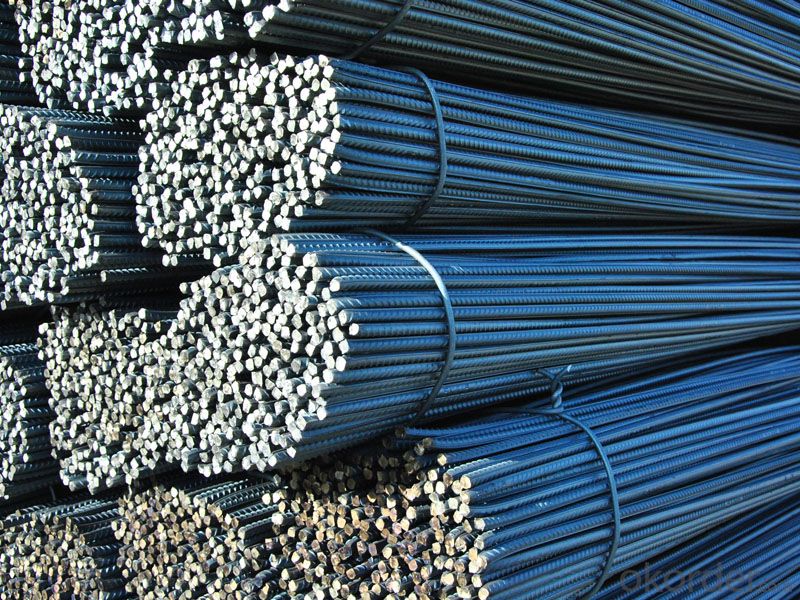
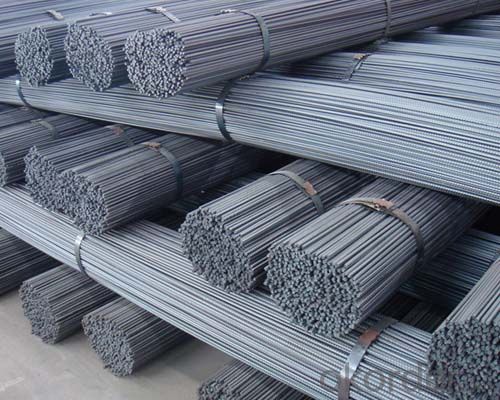
- Q: What is the specific concept of thread steel through water and what is the difference?
- The principle of water cooling technology to produce rebar is that austenite can be strongly deformed in the process of continuous rolling in the recrystallization zone, resulting in very fine, strongly hardened austenite grains with a lot of defects. With the high speed of cooling on the enhanced cooling of austenite, in a very short period of time, generally not more than 0.5s, is rapidly cooled to near the phase transition temperature, inhibit the growth of austenite grain, try to keep the hardening state of austenite. When the temperature is near the phase transition point, the fine hardening austenite grains are transformed into ferrite with proper grain size under proper air cooling conditions.
- Q: What's the difference between rebar and thread steel?
- Different strength. The design strength of round steel (HPB235) is 210MPa; the strength of thread steel is higher than that of round bar; the design strength of HRB335 is 300MPa; the design strength of HRB400 is 360MPa.
- Q: What are the weight and density of steel rebars?
- The weight and density of steel rebars can vary depending on the specific composition and size of the rebar. On average, a typical steel rebar has a density of around 7850 kilograms per cubic meter and weighs approximately 7.85 kilograms per meter.
- Q: What are the different types of coating available for steel rebars?
- There are several different types of coatings available for steel rebars, including epoxy coating, galvanized coating, and polyethylene coating. Epoxy coating provides corrosion resistance and is often used in environments where the rebar is exposed to moisture or chemicals. Galvanized coating involves applying a layer of zinc to the rebar's surface, which helps to prevent rust and corrosion. Polyethylene coating is a plastic coating that provides additional protection against corrosion and is commonly used in concrete structures.
- Q: How do steel rebars improve the durability of concrete structures?
- Steel rebars improve the durability of concrete structures in several ways. Firstly, steel rebars act as reinforcement in concrete, providing added strength and stability to the structure. When combined with concrete, the high tensile strength of steel rebars helps to resist cracking and prevent the structure from collapsing under heavy loads or seismic activities. Secondly, steel rebars help to control the formation and propagation of cracks in concrete structures. Concrete is strong in compression but weak in tension, meaning it tends to crack when subjected to tensile forces. By placing steel rebars strategically within the concrete, these cracks are minimized and prevented from spreading, thus enhancing the overall durability of the structure. Furthermore, steel rebars help to improve the resistance of concrete structures against corrosion. Concrete is highly alkaline, which forms a protective layer around the steel rebars, preventing them from rusting. This corrosion resistance ensures that the rebars maintain their structural integrity over time, reducing the risk of deterioration and enhancing the longevity of the concrete structure. In addition, steel rebars also enhance the fire resistance of concrete structures. Due to their high melting point, steel rebars can withstand high temperatures, thereby preventing the concrete from losing its structural integrity during a fire. This added fire resistance ensures that the concrete structure remains stable and safe in the event of a fire, further enhancing its durability. Overall, the inclusion of steel rebars in concrete structures significantly improves their durability by providing added strength, controlling cracks, enhancing corrosion resistance, and increasing fire resistance. These benefits contribute to the longevity and safety of concrete structures, making them more reliable and sustainable in the long run.
- Q: How do steel rebars contribute to the overall seismic resistance of a structure?
- Steel rebars contribute to the overall seismic resistance of a structure by providing reinforcement and strength to the concrete elements. The rebars help to distribute and dissipate the energy generated during an earthquake, which helps in reducing the potential damage and ensuring structural integrity. By increasing the ductility and flexural capacity of the structure, steel rebars help to absorb and withstand the seismic forces, making the building more resistant to collapse or significant structural damage.
- Q: Can steel rebars be used in decorative concrete applications?
- Yes, steel rebars can be used in decorative concrete applications. They are often used as reinforcement in decorative concrete structures to provide strength and stability. Additionally, steel rebars can be incorporated into the design to create unique and aesthetically pleasing patterns or features, enhancing the overall decorative appeal of the concrete.
- Q: Can steel rebars be used in highway barrier construction?
- Yes, steel rebars can be used in highway barrier construction. They are commonly used as reinforcement in concrete barriers to enhance their strength and durability.
- Q: What is the role of steel rebars in minimizing cracking due to shrinkage?
- The role of steel rebars in minimizing cracking due to shrinkage is to provide reinforcement and strength to concrete structures. By placing steel rebars within the concrete, they act as a framework that helps distribute the tensile forces caused by shrinkage. This prevents the concrete from cracking and ensures the overall stability and durability of the structure.
- Q: Are steel rebars suitable for use in high-rise buildings?
- Yes, steel rebars are suitable for use in high-rise buildings. Steel rebars, also known as reinforcing bars, are commonly used in the construction industry to provide strength and stability to concrete structures. High-rise buildings require a strong and durable structural system to withstand various loads and forces such as wind, earthquakes, and the weight of the building itself. Steel rebars offer excellent tensile strength and ductility, making them ideal for reinforcing concrete in high-rise structures. One of the key advantages of steel rebars is their ability to resist tensile forces. Concrete is strong in compression but weak in tension, and steel rebars help counteract this weakness by providing the necessary tensile strength. This is crucial in high-rise buildings where the weight of the structure can cause tension on the concrete elements. By reinforcing the concrete with steel rebars, the overall structural integrity of the building is enhanced, ensuring its safety and stability. Additionally, steel rebars have superior ductility, which is the ability to deform under stress without fracturing. This property is essential in high-rise buildings as they are subject to dynamic loads and potential movements caused by factors like wind or seismic activity. Steel rebars can absorb and distribute these forces, reducing the risk of structural failure or collapse. Furthermore, steel rebars are readily available and cost-effective compared to alternative materials such as carbon fiber or fiberglass. They can be easily fabricated and installed in various shapes and sizes to fit the specific design requirements of high-rise buildings. However, it is important to note that the suitability of steel rebars in high-rise buildings also depends on proper design, installation, and regular maintenance. It is crucial to follow the relevant building codes and standards, ensure proper corrosion protection, and conduct regular inspections to detect any potential issues. By adhering to these practices, steel rebars can provide a reliable and durable reinforcement solution for high-rise buildings.
Send your message to us
Hot Rolled Deformed bars with High Quality
- Loading Port:
- Tianjin
- Payment Terms:
- TT OR LC
- Min Order Qty:
- 25 m.t.
- Supply Capability:
- 10000 m.t./month
OKorder Service Pledge
OKorder Financial Service
Similar products
Hot products
Hot Searches
Related keywords
